In Summer 2010, Russia was hit by record temperatures, meagre rainfall amounts and subsequent crop loss, peat and forest fires. The extreme situation was mostly due to an exceptionally strong and persistent area of high pressure that lasted for weeks, favouring southerly flow, ample sunshine and little rain. This "blocking pattern", which effectively prevents the normal east-to-west movement of weather systems that typically bring cooler temperatures and rain, began in early July and lasted through mid-August. According to NOAA, it was the most extreme and longest lasting blocking pattern since 1920.
In the E-OBS anomaly map below, one can see that for vast areas of Western Russia and Eastern Europe, mean temperatures were between 4 and 8°C above normal during July and the first two weeks of August 2010.
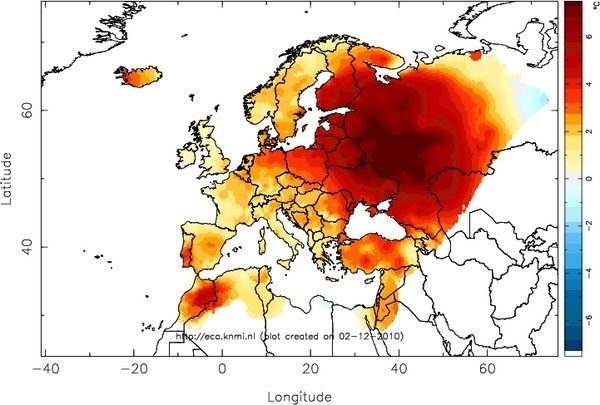
E-OBS anomalies for mean temperature during July and the first two weeks of August 2010 compared to the normal period 1961-1990.
The number of summer days, SU, where the maximum temperature is above 25°C was also well above normal. The following ECA&D anomaly map shows that for many stations, there were at least 10, and up to 30, more summer days than normal during July 2010. In Moscow, the number of summer days in July was 31; the normal is 9.5 in a year.
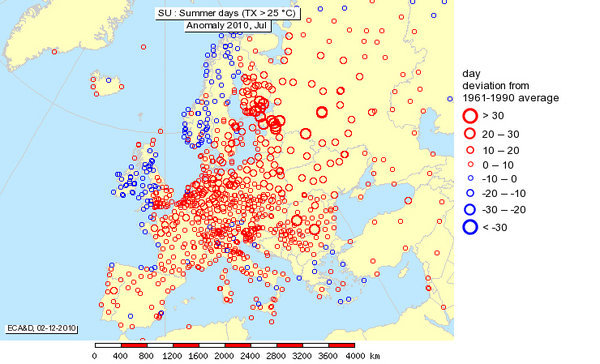
ECA&D anomaly map of the number of summer days, where the maximum temperature is above 25°C, during July 2010 compared to the normal period 1961-1990. Please click on the map for its most recent version.
The heat wave also resulted in many maximum temperature records being broken. In Moscow, the old record maximum temperature of 35.6°C, set on 11 July 1996 according to ECA&D data which begins in 1936 for this station, was broken each day from 23 July through 29 July, culminating in the city's highest temperature ever recorded: 38.2°C. Although this day was indeed extremely hot for Moscow, it was not the hottest location in the country. As seen below, several ECA&D stations southeast of Moscow reported temperatures of over 40°C on 29 July, including 41.5°C at the station Alexandrov Gaj in the province of Saratov near the border of Kazakhstan.
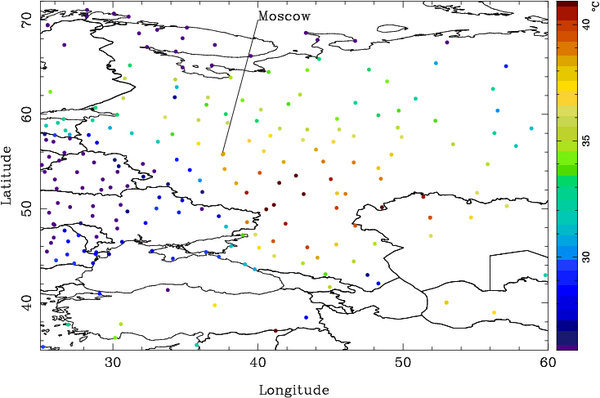
Maximum temperature at various ECA&D stations across Russia and Eastern Europe on 29 July 2010.
In addition to the extreme maximum temperatures during the day, higher than normal night-time temperatures were also observed. The following ECA&D anomaly map shows that the number of tropical nights, TR, where the minimum temperature is greater than 20°C, was up to 20 more than normal during July for some stations. Moscow experienced 16 tropical nights during July 2010; the normal is 0.5 in a year.
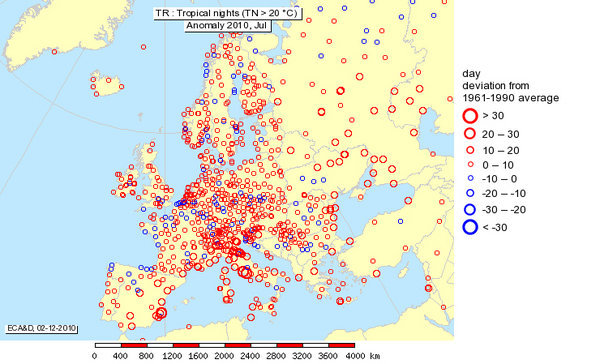
ECA&D anomaly map of the number of tropical nights, where the minimum temperature is above 20°C, during July 2010 compared to the normal period 1961-1990. Please click on the map for its most recent version.
The scorching heat during the day and the absence of rain, which began in early summer, led to the worst drought conditions in more than 100 years, according to the BBC. Data from ECA&D shows that the precipitation sums over vast areas of Ukraine and Russia, and as far south as the Black Sea, were between 100 and 200 mm below normal for the summer months of June, July and August. See the ECA&D anomaly map below.
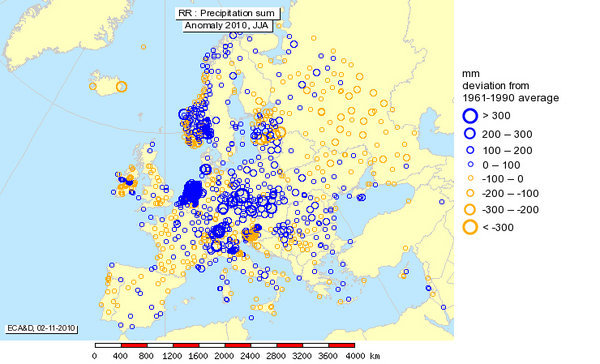
ECA&D anomaly map of precipitation sum during June, July and August 2010 compared to the normal period 1961-1990. Please click on the map for its most recent version.
The extreme drought conditions had a severe impact on crops and set the stage for the worst wild fires in decades. The NASA satellite image below shows the extent of the fires which primarily started on 28 and 29 July 2010.
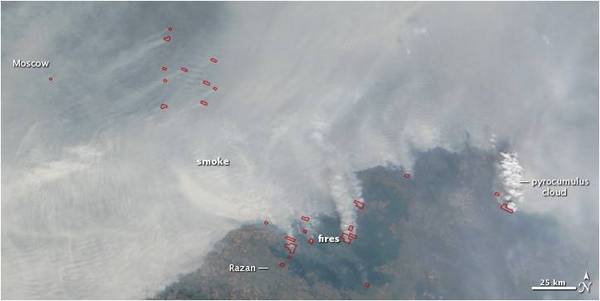
Satellite image from 4 August 2010 showing the extent of the fires. Image courtesy of earthobservatory.nasa.gov.
The massive fires severely impacted air quality. According to NASA's Earth Observatory, carbon monoxide levels in cities rose as high as six times the maximum permissible limit. The elevated pollution levels, added to the already excessive heat stress due to extreme temperatures during the day and a lack of cooling at night, had severe impacts on health. In all, the Moscow Registry Office reported that as many as 5000 people perished in Moscow alone, as the normal mortality rate doubled from 350 to 700 per day; total deaths across the entire country were estimated as high as 15,000. The Russian Meteorological Centre, having explored ancient, abnormal weather patterns by examining lake deposits, stated that the summer heat wave was likely the longest and most severe in the past one thousand years. Indeed, according to ECA&D data, the warm spell lasted between 20 and 40 days longer than normal compared to the 1961-1990 period.
Though Summer 2010 was indeed anomalously warm in Russia, there appears to be nearly no trend in maximum value of daily maximum temperature (TXx) for the ECA&D stations located there.
| 










